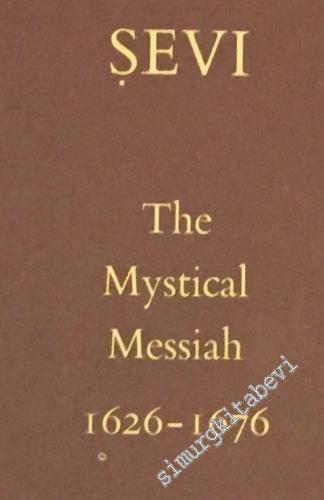
Publisher: Routledge & Kegan Paul, London
Publication Date: 1973
Binding: Hardcover
Book Condition: Very Good
Dust Jacket Condition: Very Good
A richly detailed account of the only messianic movement ever to engulf the entire Jewish world.
The twentieth century produced a galaxy of extraordinary Jewish historians. Gershom Scholem stands out among them for the richness and power of his historical imagination. Born in Berlin in 1897, Scholem became a Zionist as a young student in a revolt against his family's bourgeois and assimilated life. He learned Hebrew and studied Kabbalah, the world of mystical teachings that had become marginalized--indeed stigmatized--within the mainstream rationalist Jewish tradition. In 1923, Scholem emigrated to Palestine and eventually joined the faculty of the Hebrew University of Jerusalem, publishing groundbreaking studies in the field of Jewish mysticism.
In the 1930s, Scholem's scholarship turned to an obscure kabbalist rabbi of seventeenth-century Turkey, Sabbatai Sevi, who aroused a fervent following that spread over the Jewish world after he declared himself to be the Messiah. The movement suffered a severe blow when Sevi was forced to convert to Islam, but a clandestine sect survived. A Bollingen Foundation grant enabled Scholem to complete the original Hebrew edition of his biography in 1957. Bollingen also supported R. J. Zwi Werblowsky's masterful English translation. A monumental and revisionary work of Jewish historiography, Sabbatai Sevi stands out for its combination of philological and empirical authority and for its passion. It is widely esteemed as one of Scholem's masterworks. The author himself always regarded the Princeton/Bollingen edition as a highlight of his scholarship.
Sabbatai Zevi (1626-76) stirred up the Jewish world of the mid-seventeenth century by claiming to be the messiah, then stunned it by suddenly converting to Islam. His story, and that of the movement he created, is a landmark event in early modern Jewish history and a dramatic example of what can happen when mystic dreams and messianic hopes combine in an explosive mixture. Now, for the first time, English readers can experience these events through the words of those who lived through them, in lucid and compelling translations by a leading authority in the field. Of the contemporary 'testimonies' translated by David J. Halperin, three are accounts by Sabbatai Zevi's followers of the life and deeds of their messiah. These are the Najara Chronicle, an eyewitness narrative which Gershom Scholem called 'one of the most extraordinary documents shedding light on Sabbatai's personality'; Baruch of Arezzo's Memorial to the Children of Israel, a sober yet devout biography of Sabbatai written shortly after his death; and the bizarrely fanciful hagiography composed in 1692 by Abraham Cuenque of Hebron. These narratives by Sabbatean 'believers' are supplemented by two seventeenth-century letters, pungent in their style and colourful in their details, in which Sabbatai and his followers are described by a contemporary rabbi who detested them and everything they stood for. Finally, a reminiscence of Sabbatai's last days, preserved by one of the most independent-minded of his followers, conveys the enigma of the man who was to haunt the generations.
Publisher: Routledge & Kegan Paul, London
Publication Date: 1973
Binding: Hardcover
Book Condition: Very Good
Dust Jacket Condition: Very Good
A richly detailed account of the only messianic movement ever to engulf the entire Jewish world.
The twentieth century produced a galaxy of extraordinary Jewish historians. Gershom Scholem stands out among them for the richness and power of his historical imagination. Born in Berlin in 1897, Scholem became a Zionist as a young student in a revolt against his family's bourgeois and assimilated life. He learned Hebrew and studied Kabbalah, the world of mystical teachings that had become marginalized--indeed stigmatized--within the mainstream rationalist Jewish tradition. In 1923, Scholem emigrated to Palestine and eventually joined the faculty of the Hebrew University of Jerusalem, publishing groundbreaking studies in the field of Jewish mysticism.
In the 1930s, Scholem's scholarship turned to an obscure kabbalist rabbi of seventeenth-century Turkey, Sabbatai Sevi, who aroused a fervent following that spread over the Jewish world after he declared himself to be the Messiah. The movement suffered a severe blow when Sevi was forced to convert to Islam, but a clandestine sect survived. A Bollingen Foundation grant enabled Scholem to complete the original Hebrew edition of his biography in 1957. Bollingen also supported R. J. Zwi Werblowsky's masterful English translation. A monumental and revisionary work of Jewish historiography, Sabbatai Sevi stands out for its combination of philological and empirical authority and for its passion. It is widely esteemed as one of Scholem's masterworks. The author himself always regarded the Princeton/Bollingen edition as a highlight of his scholarship.
Sabbatai Zevi (1626-76) stirred up the Jewish world of the mid-seventeenth century by claiming to be the messiah, then stunned it by suddenly converting to Islam. His story, and that of the movement he created, is a landmark event in early modern Jewish history and a dramatic example of what can happen when mystic dreams and messianic hopes combine in an explosive mixture. Now, for the first time, English readers can experience these events through the words of those who lived through them, in lucid and compelling translations by a leading authority in the field. Of the contemporary 'testimonies' translated by David J. Halperin, three are accounts by Sabbatai Zevi's followers of the life and deeds of their messiah. These are the Najara Chronicle, an eyewitness narrative which Gershom Scholem called 'one of the most extraordinary documents shedding light on Sabbatai's personality'; Baruch of Arezzo's Memorial to the Children of Israel, a sober yet devout biography of Sabbatai written shortly after his death; and the bizarrely fanciful hagiography composed in 1692 by Abraham Cuenque of Hebron. These narratives by Sabbatean 'believers' are supplemented by two seventeenth-century letters, pungent in their style and colourful in their details, in which Sabbatai and his followers are described by a contemporary rabbi who detested them and everything they stood for. Finally, a reminiscence of Sabbatai's last days, preserved by one of the most independent-minded of his followers, conveys the enigma of the man who was to haunt the generations.


















